If you were wondering where Andy South has been recently, he has been working on his latest book detailing the career of HMAS Sydney! His first volume of H.M.A.S SYDNEY: A chronological history is completed. Andy wanted to share some of his book so he as kind enough to send us an excerpt. Enjoy! – Navy General Board
CHAPTER 10: THE FLEET ARRIVES
Seventy-eight miles to the north lay Australia’s most populated city, Sydney, were with much excitement awaiting the arrival of the nation’s new fleet was much anticipated. As the city prepared to welcome their new battlecruiser, cruiser and their five companion ships, the ratings were set to cleaning and painting the fleet. Other ratings set about installing the “illuminating” circuits once more. Then at 17:00, with the R.A.N’S new flagship leading the way, the squadron steamed north for its grand entrance into one of the world’s finest harbours, Sydney. In the battlecruisers wake came the cruisers in order of Sydney, Melbourne, Encounter. The three destroyers followed their larger companions, stationed one mile off on the starboard beam. As the Sydney steamed second in the line ahead formation, the Admiral fleet adjusted his ship’s rate of knots to time their arrival for the morning and the crews applied a last lick of paint and completed the cleaning of their ships. A correspondent from the Sydney Morning Herald described the fleets passage that night:
“Late on Friday night the fleet was some 30 or 40 miles east of the Australian coast. Going on deck for a breath of air before turning in, one found the quarter-deck pitch black. Only aft, under the low awning, the dark shield of the after six-inch gun stood out against a restless waving light reflected in the silky water of our wake. From where I stood the lights that caused that reflection were in visible-shut out by the awning. But as one moved towards the stern they came into view-the sidelights, masthead lights and steaming lights of the Encounter. Far away on the beam was a set of faint white lights, low on the water; a second set and third, at intervals, astern of it. One knew that those were the destroyers. Indeed, we were far outside the route of coastal traffic. After leaving Jervis Bay the destroyers, which at first had been astern, had been ordered to take station parallel to the fleet. In the morning they were still there, moving steadily about a mile abreast of us and the Encounter’s ram was sawing the water, as it had done all night, just 350 yards astern of us. In short, we were steaming as a fleet, in close order, an event which did not often happen in the training of the old Australian squadron, but which will be a constant part of the training of the new”.
HMAS Sydney had steamed over the last 101 days, 15,447 miles and in the process burnt 5,005 tons of coal, or 3.08 tons of coal for every one of those miles. Now, after much anticipation on board the ships, with the government, navy, local papers and the countrys population, the Royal Australian Navy’s first fleet drew closer to the entrance to what was the premier port on the continent, Sydney.
The early morning of Saturday the 4th of October 1913 was a wet one, with rain falling on the harbour in torrents. But the crowds seeking shelter where they could, or just accepting the deluge had gathered early, to secure the best positions to watch Vice-Admiral Patey bring the country’s new fleet into port. Every piece of accessible shore line was crowded and the harbours waters were filled with hundreds of small craft. Pleasure boats, yachts, ferries and small boats, each filled to its capacity.
The Sydney Morning Herald noted the ships arrival off Sydney:
“..It must have been some time between 6.30 and 7 o’clockand the white light of morning was streaming in through the port, when, looking out, one could see that we were already close in to the land. A heavy mist hung over it and made the distance difficult to judge, but through it one could make out dimly the form of what seemed to be North Head. The request to the Admiral had been to make the entry to the Heads at 10.30and so the fleet altered course again and the land soon vanished in the mist. Those who saw the arrival of the American fleet will remember that a special request was sent to Admiral Sperry by wireless to make the coast at Maroubra, which he agreed to do. The American fleet, on arrival at this spot at dawn, turned up the coast and was about to enter the Heads, some two hours earlier than was expected, but was induced, by urgent representations of those who boarded the Connecticut with the pilots, to postpone the entrance until the time arranged. He accordingly turned his fleet to sea and , after standing out for some distance, led his line round and entered the harbour. It is a curious coincidence that a very similar course was taken by the Australian fleet five years later. Owing to the heavy mist, however, the ships were not seen from the South Head signal station.
It was about a quarter past 8 when the flag-ship turned a complete half-circle to port. This time the destroyers took station astern of the Encounter and the whole fleet, in single line ahead, steamed back along the course which it had just travelled and made for Sydney Heads. At the time when we turned in again North Head may have been about 20 miles away.
I was in the Sydney’s engine-room, taking a last look at the marvels there, when the telegraph rang to stop. When a ship stops or goes astern or alters speed, that is all the engine-room knows about it. Why she should stop or quicken or slacken speed is no concern of theirs. Possibly we were altering course
again and had to reduce speed in doing so. That is no affair of the engine-room. All they know down there is that the turbines must stop. They will remain stopped until they are told to go again. Then somebody turns one wheel, just one large wheel in a corner somewhere, the same which they turned when they stopped her-and the ship goes ahead”.
HMAS Franklin, a 1906 steel hulled yacht had departed from the harbour early with the Governor-General Sir Ronald Munro Ferguson on board, to meet and escort the fleet into its new home port. The warships and yacht met off the Sydney Heads at 09:20and Captain Glossop having joined the Governor-General on board the Franklin, the yacht with the fleets in its wake, made a slow but steady progress into the harbour. Pleasure boats and small boats milled around the flotilla, some boats leaning close to capsizing with the passengers along one side of their craft in an effort to secure the best view of the fleet. At 09:30 the Federal Ministers and his party left No.1 jetty, Fort Macquarie on board S.S. Kubu, while the State Minister and his party boarded the S.S. Captain Cook which departed from the ‘P&O’ Wharf, on the Circular Quay at 09:30. Fifteen minutes prior, the S.S Hunter, with a band and schoolboy choir aboard set sail from the Flood’s wharf (north aide), Circular Quay.
“Citizen naval forces” from the naval base at Rushcutter Bay assemble at the Garden Island Base, in company with a band and buglers, the gathering being overseen by a Lieutenant Fearnley. Also at Garden Island, the Australian Naval Reserve, military and civilian officers, with the army and navy veterans assembled.
The Herald once more:
“By the time we reached the deck the fleet was moving as before. The mist was rising now and far ahead of us we could make out the line of the South Head cliffs. Beneath them could faintly be seen the smoke of some steamer coming out. To the south-east were one or two other smudges of brown smoke. They seemed to be making towards the port. By the brown cloud of smoke they were evidently hurrying. It was one of the big sea-ports of the world that we were coming to and as we neared it the signs of its traffic increased. But one speculated for a moment what business merchant steamers could have in that particular direction. It was not a trade route to anywhere, except the South Pole. A small coaster, bound for some North Coast inlet, steamed down along the whole line before turning north upon her proper errand. We could see the skipper and the mate leaning over the bridge to watch us, whilst the cook and most of the hands leant over the rail below. A motor launch or two coughed past. The first steamer that we had seen ahead had a curious list to port. As she came nearer we noticed a peculiar mass of dark colour covering the whole of her port side, bulwarks, deck, upper works, piled even high up the rigging.
And then, with a flash, it came upon one, that it was not the Hawkesbury that this steamer was bound for. Those fuming black smudges to the south-east were not making for Sydney. They were making for us. I doubt if there were many in the fleet who realized until that moment that we were really the centre of attraction. It was only bit by bit, as sight after sight opened out, that there was driven in upon one the full impression of this reception. The excursion steamer was passing us by this time. Across the water we could hear them cheering, hats were waving, handkerchiefs flying. We were Sydney’s namesake and I had been long enough in the ship to know that the fact means something to her. Those cheers did not go unappreciated
It was just about this time we were about five miles east of Sydney Heads-when someone first noticed, using a strong glass, a certain dark fringe above the edge of some of the cliffs at South Head. Looking again one was convinced that it was just the grassy slope which surmounted the Heads. Following the skyline with the glasses towards the south one saw that this same shaded line was there, too-rising and falling with the edge of the cliffs until it ran out into the haze in the direction of Bondi. The suspicion did just enter one’s brain that it might be….But I took another long, hard look and look and a friend who was standing by me and who was far more used to telescopes than I, agreed it could not be.
But it was. A few minutes later there was no doubt of it. The whole skyline was crowded with forests of people. Every shoulder and summit was black with them. One followed the line of them without a break.
….past the lighthouse, past the signal station, down the rim of the Gap, until the ship’s side shut out the further view. By this time every person, who was not officially supposed to be seen, was off the ship’s deck. The full guard was paraded on the quarterdeck. The sides were lined with seamen in blue serge and straw hats. An officer, in engine-room rig, came to the side for a moment. Someone told him that the crowd on the Heads could be seen. “Then it’s time for me to get out of sight,” he said and dived down to his work again. A few moments later the same door, into which he had disappeared, opened ever so little and two heads with the sweat of hard work on their foreheads, appeared at the chink.
I saw them there again afterwards at intervals, until we moored. But this time, when we were close under South Head and the cliffs around the lighthouse were swimming slowly past our field of view, one head came out further than the other and after taking in the scene with one comprehensive stare, turned to its mate. “Fahsands, Bill, Fahsands,” he said.
It was exactly 10.30 a.m. by my watch when the flagship turned round the Hornsby light and into Sydney Harbour. The Melbourne, Sydney, Encounter, Warrego, Yarra and Parramatta followed her in that order. The cruisers were keeping station at 2½ cables and the destroyers at 1¼ cable. And those of us who will live to see this fleet expanded to six times its present size will never see station more prettily kept than in this first fleet as it entered its home harbour. The intervals at this point were practically perfect. All the ships were “dressed” as far as any ship dresses when she is at sea. That is to say, they carried the Australian flag at the fore and the White Ensign at the main. In the flagship the Rear-Admiral’s flag flew side by side with the blue Australian ensign on the foremast.
I have never seen Sydney Harbour look truer to itself than on this day. The sun was shining, the water was blue, the fore-shores were bathed in light. As we opened it out we could see first the craft lined up off Middle Head, three Manly ferry steamers all heeling at a heavy angle, the Kubu, the Captain Cook, boats of all sorts and sizes. Then came the masses of people on the inner slopes of South Head, masses at Bradley’s Head, masses at Mosman, masses in Rose Bay. There was a good deal of interest on board as we passed the naval reserve drawn up at Garden island. But it was not until we caught our first glimpse of the Domain and of the slopes of Government House grounds that the full force of the spectators was realized.
“I thought we had seen all Sydney at the Heads,” an officer said to me, “but where do these come from?”
At 10:40 the ships passed Green Point, as warships and pleasure boats made their way deeper into the anchorage. But despite the hundreds of craft escorting the fleet, the route was kept clear for the warships. As the crowds cheered themselves hoarse, from a tethered balloon a man parachuted down slowly passing over the warships. The Admiral ordered the firing of a 17 guns salute, to which Rear-Admiral king-Hall, Commander in Chief of the Australia Station ordered the reply salute and by 11:03, the fleet had let go its anchors, the Sydney being secured to the No 3 buoy. Once moored, the ship’s crews proceeded to dress their vessels over all with flags and bunting. The fleets officers went ashore to undertake a series of official calls, some to the flag bedecked Town Hall. While their officers undertook the official calls, the warships released parties ashore of leave. On the Sydney the Starboard watch, looked on as their shipmates of the port watch were granted the first overnight shore leave of the visit. The ratings were allowed ashore from 13:15 until the following morning at 07:00. The ship’s boys went ashore the same time, but were to report back on board by 19:00. While their crew mates explored the city, the starboard watch strung lights on the rigging for use that evening. Then at 17:55 the crew undressed the ship and between 20:00 and midnight the fleet was brightly Illuminated by its own searchlights and the strings of coloured lights along the rigging. As the fleet lay bathed in bright lights the shoreline too was illuminated, the harbour lit as if from a galaxy of lights that had descended upon it.
The Herald concluded its article:
“As we turned Bradley’s we had seen the flagship steaming through wreaths of smoke from her own guns as the Rear-Admiral in command of the arriving Australian fleet saluted with 17 guns the Admiral commanding in chief. Afterwards we saw the Cambrian returning the salute with 13 guns for a Rear-Admiral. Then the flagship, the Melbourne and the Sydney at the same instant reached their buoys; two destroyers swept past us to Farm Cove. A third turned in off Garden Island. The Encounter was moving past us on the other beam to take a position off Neutral-Bay. She had to signal some small fry there that she was turning to starboard. Presently we saw her port anchor splash and the rust running out of her hawse-pipes. A lather of water came forward along her side as she went astern to swivel her two cables.
So long as it is free to move and go about its business, a fleet does not cover itself with strings of flags. But the signal had been made that the fleet was to be dressed as soon as the ships were secured. The Encounter had scarcely let go her second anchor and the Sydney’s hawser was just on the buoy, when the signal was given and the whole fleet burst in a second into a mass of colour.
It is no exaggeration to say that those on board were honestly surprised by the reception. By some of those in authority it has perhaps been looked forward to, as to my knowledge was the case in the American fleet also with mixed feelings. The flagship and the Sydney have now had a procession of fete’s lasting over two months and the fleet feels, as the American fleet did at the end of a similar cruise, that it ought soon to be getting to work. It Is not easy for young seamen to perform work for which they have been only half trained and there are many young sea-men in this fleet. Over and above this, the rigging of ships for illuminations, the opening of ships to visitors and the attendance of certain shore functions, such as the review, gladly though they are undertaken, entail an amount of trouble of which people ashore have not the remotest conception. The display which was given to the spectators last night, when the ships flashed suddenly into light, was only attained by constant hard work, which began at Albany and was continued at Jervis Bay. All the time, although routine is necessarily broken, the ordinary work of the ship has to go on and when it is explained that a single six-inch gun is such a complicated affair nowadays that it takes two men half an hour a day to keep it clean and it must be kept clean unless the Australian navy is not to be in the same class as that of Turkey, It can be understood what that work is. For that reason, when the present week is over officers and men will probably welcome a quiet spell in which the necessary instruction can be given and the ships can fit themselves to make the good showing which all on board desire them to make, when gunnery and other results come to be compared with those of the mother navy. Fleet week in Sydney is looked forward to as a sort of grand finale of the festivities. It means a great deal to this fleet to know that it has the whole country behind it. The reception in Sydney has been looked forward to with a great deal of curiosity and interest. And there is no question that the fleet was impressed by it. It is said that the Admiral was honestly delighted. And amongst the officers, even with those who were inclined to be somewhat sceptical as to fleet weeks, the sentiment was summed up in an expression of honest admiration which I heard from more than one, “Well, they’ve done this thundering well.” There are hundreds of Sydney men in these ships; and they could not help being pleased with the remarks which fell around them and in their hearts they endorsed every word. For the harbour was simply radiant. As launch after launch, crowded with laughing faces and gay colours, swept round the ships one could not help wondering if there were any setting in the world so fitted for such a scene. “I’ve heard a lot of Sydney,” said one of those whose kindness had made the past three days a thorough holiday for me, as he looked round over the glancing water. “I’ve heard a lot, but the half was not told me.”
Once the fleet was at anchor, Rear Admiral Sir George Patey boarded his Admirals Barge and made a “call” on Admiral Sir George King-Hall on board the cruiser HMS Cambrian and afterwards he went ashore, being met on the quay by an honour guard to make a similar “call” on the Naval Board at Admiralty House, where he was presented by the board to the Governor-General. The Rear-Admiral also called on the State Governor. The RN Australian station Admiral King-Hall hosted the official luncheon in Admiralty House. In the afternoon four hundred officers and men from both Australia and Sydney went ashore to attend a meeting at the A.J.C. race meeting at Randwick.
In the evening a Federal Government banquet for the fleet was held at the Town Hall at 19:30 with the Governor-General presiding. Later in the evening the fleet and city were illuminated.
A “Venetian carnival” was held in Farm Cove,and in the grounds of Government House Bands played, as well as in a barge moored off Farm Cove, close to Macquaries Point. It was also made clear that only Illuminated rowing boats were to be permitted to move about the Cove between 19:30 and 21:30.
If you would like to continue reading into the history of HMAS Sydney, be sure to check out Andy’s book:
H.M.A.S SYDNEY: A chronological history. Volume1. (The pre-war year 1913-14)
Further Links
Who Won the Battle of Jutland?

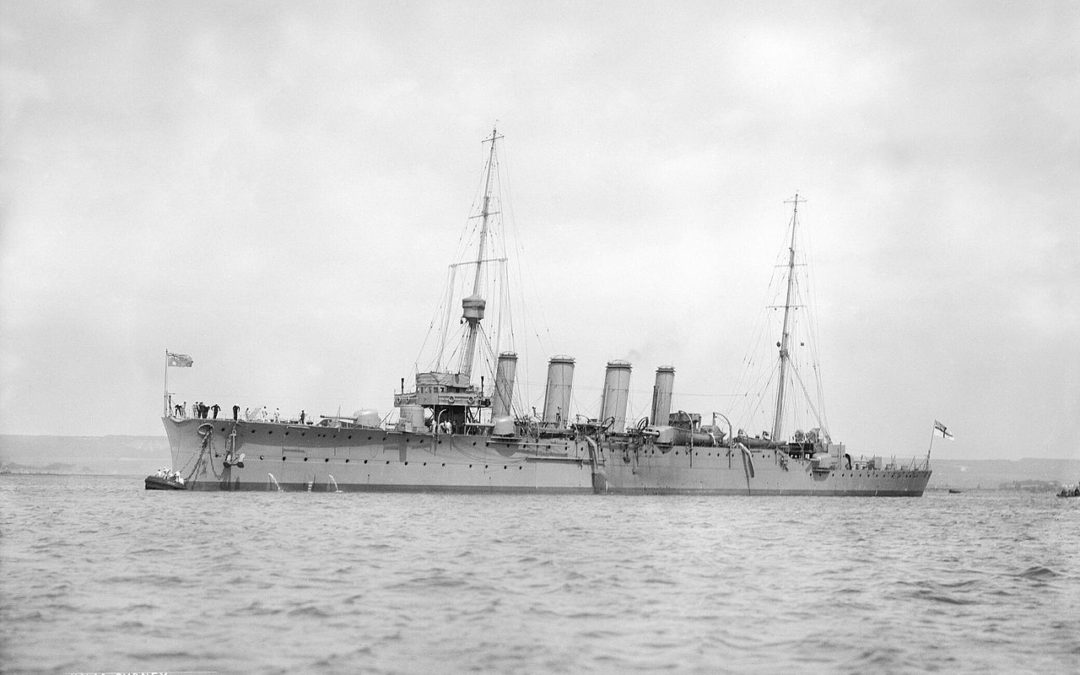
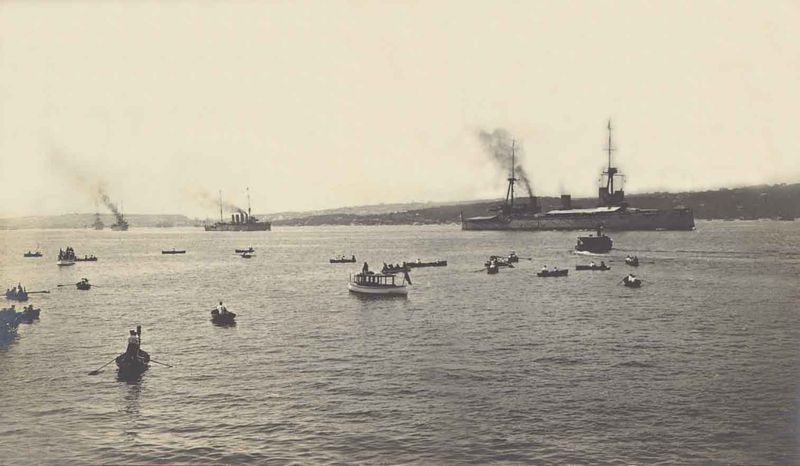

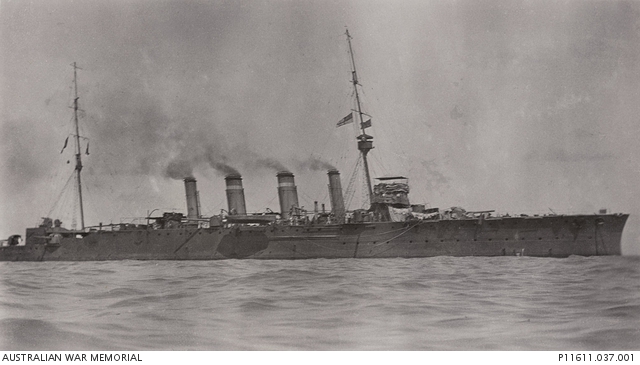
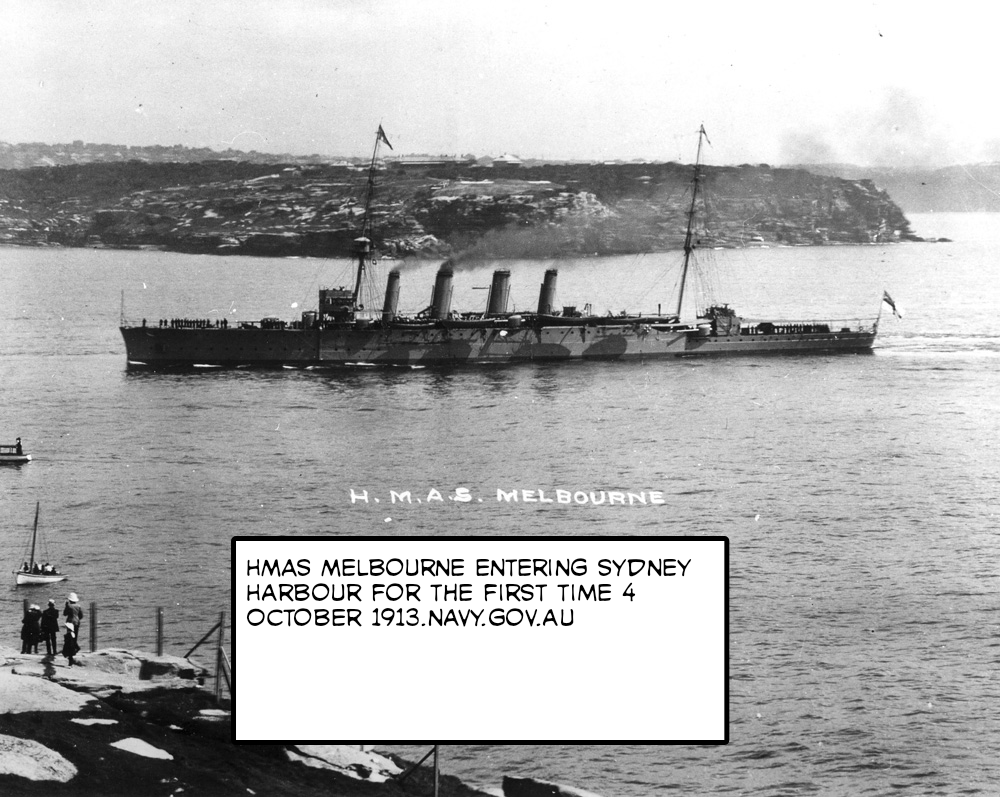
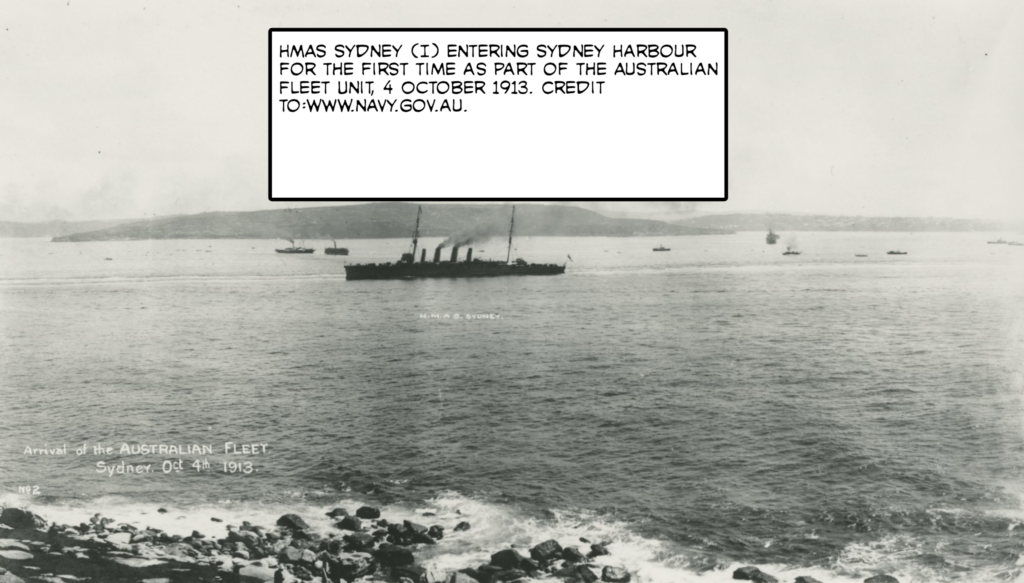
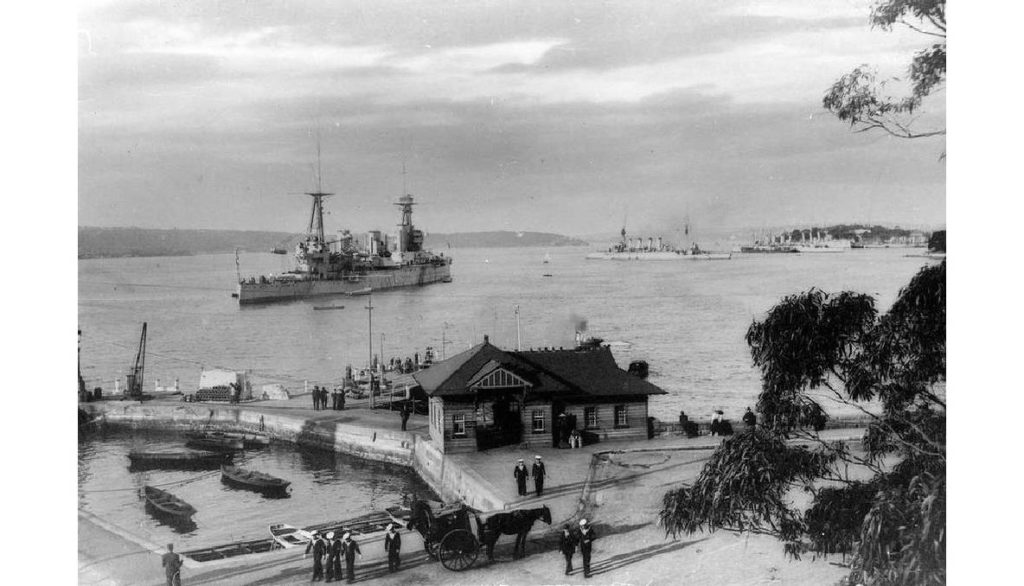
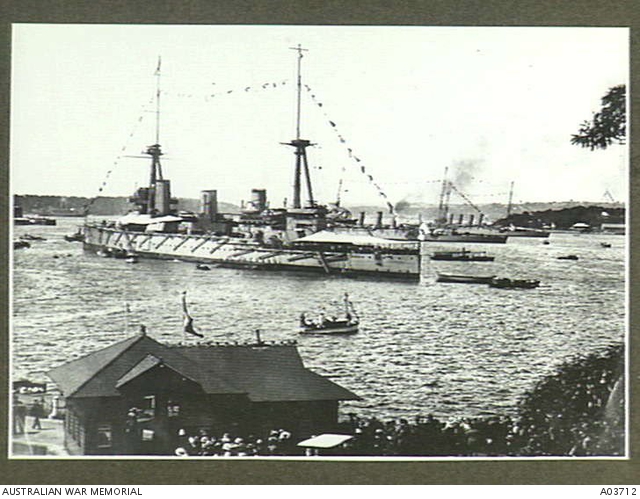
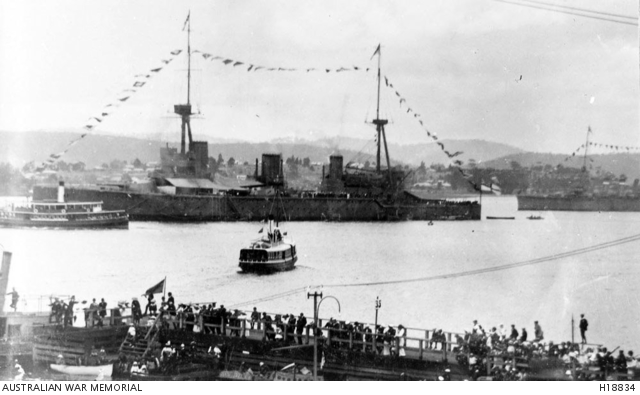
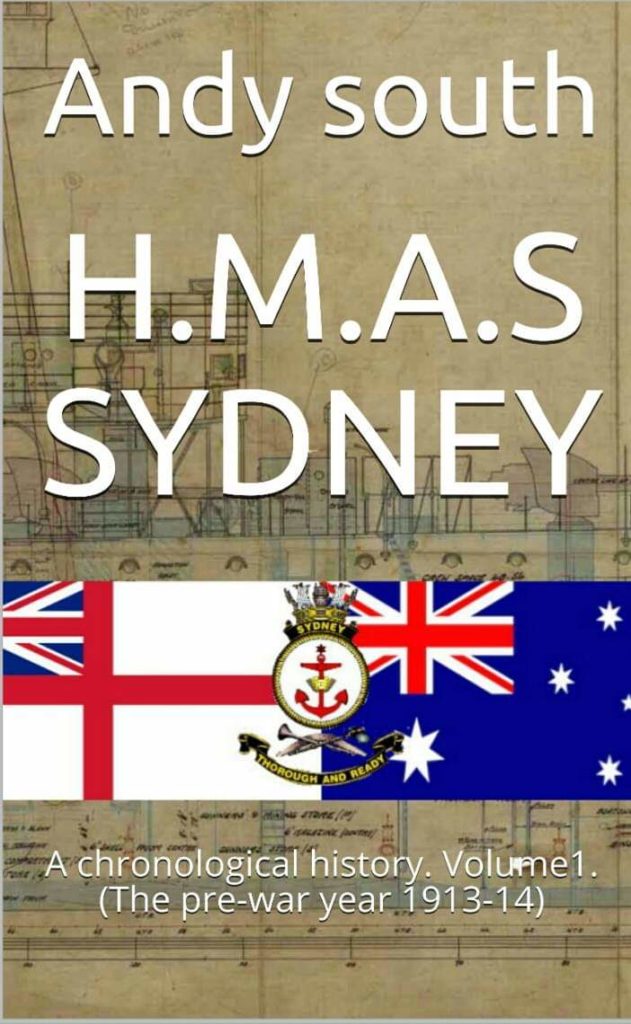

Recent Comments